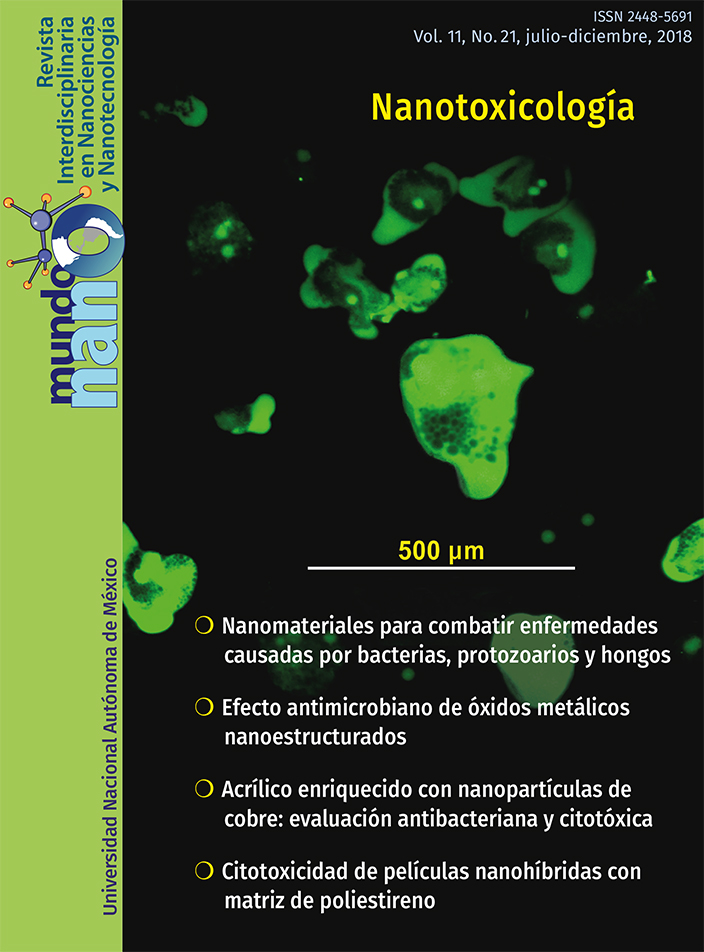Mecanosíntesis y efecto antimicrobiano de óxidos metálicos nanoestructurados
Resumen
Actualmente existe un gran interés en Centro de Ciencias Aplicadas y Desarrollo Tecnológico (CCADET) de la UNAM, por el desarrollo de métodos innovadores que permitan obtener materiales nanoestructurados y en particular aquellos formados por óxidos metálicos, con actividad antimicrobiana. En este artículo se presenta lo que el grupo de investigación de la Dra. América Vázquez ha llevado a cabo sobre la mecanosíntesis de una serie de óxidos nanoestructurados formados por CuO, CuBi2O4, ZnO, Mn3O4, Fe2O3, CuFe2O4, ZnFe2O4 y MgO, así como una revisión sobre las aplicaciones de dichos óxidos, como agentes antimicrobianos.
La principal motivación de esta investigación radica en el hecho de que el desarrollo de nuevos antibióticos, a pesar de ser constante, resulta inútil cuando los microorganismos se vuelven multirresistentes. Por tal razón, se han buscado nuevas formas de combatir dichas infecciones y en este sentido, las nanopartículas (NPs) formadas por óxidos metálicos han resultado ser una nueva herramienta en la lucha contra las enfermedades causadas por microorganismos que cada vez se vuelven más resistentes a los tratamientos convencionales con diversos antibióticos.
Citas
Azhir, E., Etefagh, R., Mashreghi, M., Pordeli, P. (2015). Preparation, characterization and antibacterial activity of manganese oxide nanoparticles. Physical Chemistry Research, 3(3): 197-204.
Bindhu, M., Umadevi, M., Micheal, M. K., Arasu, M. V., Al–Dhabi, N. A. (2016). Structural, morphological and optical properties of MgO nanoparticles for antibacterial applications. Materials Letters, 166: 19-22.
Chowdhury, A.–N., Azam, M. S., Aktaruzzaman, M., Rahim, A. (2009). Oxidative and antibacterial activity of Mn3O4. Journal of hazardous materials, 172(2): 1229-1235.
Elaziouti, A., Laouedj, N., Bekka, A. (2016). Synergetic effects of Sr-doped CuBi2O4 catalyst with enhanced photoactivity under uva–light irradiation. Environmental Science and Pollution Research, 23(16): 15862-15876.
Fernández–Osorio, A., Vázquez–Olmos, A., Sato–Berru, R., Escudero, R., Fernández–Osorio, A., et al. (2009). Hydrothermal synthesis of co3o4 nanooctahedra and their magnetic properties. Rev Adv Mater Sci, 22: 60-66.
Fernández–Osorio, A., Castañeda–Guzmán, R., Vázquez–Olmos, A., Huanosta–Tera, A. (2007). Photoacoustic and dielectric study of lead zirconate titanate nanoparticles. Ferroelectrics 361(1): 92-104.
Fernández–Osorio, A., Jiménez–Segura, M., Vázquez–Olmos, A., Sato–Berru, R. (2011). Turquoise blue nanocrystalline pigment based on Li 1.33 Ti 1.66 O 4: Synthesis and characterization. Ceramics International, 37(5): 1465-1471.
Fernández–Osorio, A., Rivera, C., Vázquez–Olmos, A., Chávez, J. (2015). Luminescent ceramic nano-pigments based on terbium-doped zinc aluminate: Synthesis, properties and performance. Dyes and Pigments, 119: 22-29.
Gaffet, E., Bernard, F., Niepce, J.–C., Charlot, F., Gras, C., Le Caër, G. et al. (1999). Some recent developments in mechanical activation and mechanosynthesis. Journal of materials chemistry, 9(1): 305-314.
Groiss, S., Selvaraj, R., Varadavenkatesan, T., Vinayagam, R. (2017). Structural characterization, antibacterial and catalytic effect of iron oxide nanoparticles synthesised using the leaf extract of Cynometra ramiflora. Journal of Molecular Structure, 1128: 572-578.
He, Y., Ingudam, S., Reed, S., Gehring, A., Strobaugh, T. P., Irwin, P. (2016). Study on the mechanism of antibacterial action of magnesium oxide nanoparticles against foodborne pathogens. Journal of nanobiotechnology, 14(1): 54.
Heinicke, G., Hennig, H. P., Linke, E., Steinike, U., Thiessen, K. P., Meyer, K. (1984). Tribochemistry Akademie–Verlag, Berlin 1984 495 S., 329 Abb., 106 Tab. Preis: 98,–M. Crystal Research and Technology, 19(11): 1424-1424.
Hemeg, H. A. (2017). Nanomaterials for alternative antibacterial therapy. International journal of nanomedicine: 12: 8211.
Hou, J., Wang, X., Hayat, T., Wang, X. (2017). Ecotoxicological effects and mechanism of CuO nanoparticles to individual organisms. Environmental Pollution: 221: 209-217.
Irshad, R–, Tahir, K–, Li, B–, Ahmad, A–, Siddiqui, A. R., Nazir, S. (2017). Antibacterial activity of biochemically capped iron oxide nanoparticles: A view towards green chemistry. Journal of Photochemistry and Photobiology B: Biology, 170: 241-246.
Jan, T., Iqbal, J., Ismail, M., Badshah, N., Mansoor, Q., Arshad, A. et al. (2014). Synthesis, physical properties and antibacterial activity of metal oxides nanostructures. Materials Science in Semiconductor Processing, 21: 154-160.
Jin, T., He, Y. (2011). Antibacterial activities of magnesium oxide (MgO) nanoparticles against foodborne pathogens. Journal of Nanoparticle Research, 13(12): 6877-6885.
Kaftelen, H., Ocakoglu, K., Thomann, R., Tu, S., Weber, S., Erdem, E. (2012). EPR and photoluminescence spectroscopy studies on the defect structure of ZnO nanocrystals. Physical Review B, 86(1): 014113.
Kalyani, R. L., Venkatraju, J., Kollu, P., Rao, N. H., Pammi, S. V. N. (2015). Low temperature synthesis of various transition metal oxides and their antibacterial activity against multidrug resistance bacterial pathogens. Korean Journal of Chemical Engineering, 32(5): 911-916.
Katwal, R., Kaur, H., Sharma, G., Naushad, M., Pathania, D. (2015). Electrochemical synthesized copper oxide nanoparticles for enhanced photocatalytic and antimicrobial activity. Journal of Industrial and Engineering Chemistry, 31: 173-184.
Kefeni, K. K., Mamba, B. B., Msagati, T. A. (2017). Application of spinel ferrite nanoparticles in water and wastewater treatment: A review. Separation and Purification Technology, 188: 399-422.
Krishnamoorthy, K., Manivannan, G., Kim, S. J., Jeyasubramanian, K., Premanathan, peroxidation by oxygen vacancy. Journal of Nanoparticle Research, 14(9): 1063.
Król, A., Pomastowski, P., Rafińska, K., Railean–Plugaru, V., Buszewski, B. (2017). Zinc oxide nanoparticles: Synthesis, antiseptic activity and toxicity mechanism. Advances in Colloid and Interface Science.
Lemire, J. A., Harrison, J. J., Turner, R. J. (2013). Antimicrobial activity of metals: mechanisms, molecular targets and applications. Nature Reviews Microbiology, 11(6): 371.
Mamonova, I., Babushkina, I., Norkin, I., Gladkova, E., Matasov, M., Puchin’yan, D. (2015). Biological activity of metal nanoparticles and their oxides and their effect on bacterial cells. Nanotechnologies in Russia, 10(1-2): 128-134.
Mandal, S., Natarajan, S., Tamilselvi, A., Mayadevi, S. (2016). Photocatalytic and antimicrobial activities of zinc ferrite nanoparticles synthesized through soft chemical route: A magnetically recyclable catalyst for water/wastewater treatment. Journal of Environmental Chemical Engineering, 4(3): 2706-2712.
Muthukumar, H., Chandrasekaran, N. I., Mohammed, S. N., Pichiah, S., Manickam, M. (2017). Iron oxide nano-material: Physicochemical traits and in vitro antibacterial propensity against multidrug resistant bacteria. Journal of Industrial and Engineering Chemistry, 45: 121-130.
Prado, V., Vidal, R., Durán, C. (2012). Aplicación de la capacidad bactericida del cobre en la práctica médica. Revista médica de Chile, 140(10): 1325-1332.
Raghunath, A., Perumal, E. (2017). Metal oxide nanoparticles as antimicrobial agents: A promise for the future. International journal of antimicrobial agents, 49(2): 137-152.
Rankin, D. W. (2009). CRC handbook of chemistry and physics, David R. Lide (ed.): Taylor & Francis.
Rufus, A., Sreeju, N., Philip, D. (2016). Synthesis of biogenic hematite (α-Fe2O3) nanoparticles for antibacterial and nanofluid applications. RSC Advances, 6(96): 94206-94217.
Santhoshkumar, J., Kumar, S. V., Rajeshkumar, S. (2017). Synthesis of zinc oxide nanoparticles using plant leaf extract against urinary tract infection pathogen. Resource–Efficient Technologies, 3(4): 459-465.
Sawai, J., Kojima, H., Igarashi, H., Hashimoto, A., Shoji, S., Sawaki, T. et al. (2000). Antibacterial characteristics of magnesium oxide powder. World Journal of Microbiology and Biotechnology, 16(2): 187-194.
Sawai, J. (2003). Quantitative evaluation of antibacterial activities of metallic oxide powders (ZnO, MgO and CaO) by conductimetric assay. Journal of microbiological methods, 54(2): 177-182.
Sawai, J., Yoshikawa, T. (2004). Quantitative evaluation of antifungal activity of metallic oxide powders (MgO, CaO and ZnO) by an indirect conductimetric assay. Journal of applied microbiology, 96(4): 803-809.
Stankic, S., Suman, S., Haque, F., Vidic, J. (2016). Pure and multi metal oxide nanoparticles: Synthesis, antibacterial and cytotoxic properties. Journal of nanobiotechnology, 14(1): 73.
Tadic, M., Kopanja, L., Panjan, M., Kralj, S., Nikodinovic-Runic, J., Stojanovic, Z. (2017). Synthesis of core-shell hematite (α-Fe2O3) nanoplates: Quantitative analysis of the particle structure and shape, high coercivity and low cytotoxicity. Applied Surface Science, 403: 628-634.
Vázquez–Olmos, A., Ramos–Bautista, A., Fern, A., Sato–Berru, R. (2008). Co3O4 and CuO nanoparticles obtained by a solvent-free method. Nano Science & Nano Technology: An Indian Journal, 2(1).
Vázquez–Olmos, A., Redón, R., Fernández–Osorio, A., Saniger, J. (2005a). Roomtemperature synthesis of Mn3O4 nanorods. Applied Physics A: Materials Science & Processing, 81(6): 1131-1134.
Vázquez–Olmos, A., Redón, R., Rodríguez–Gattorno, G., Mata–Zamora, M. E., Morales–Leal, F., Fernández–Osorio, A. L. et al. (2005b). One-step synthesis of Mn 3 O 4 nanoparticles: Structural and magnetic study. Journal of colloid and interface science, 291(1): 175-180.
Vázquez–Olmos, A., Redón, R., Fernández–Osorio, A., Sato–Berrú, R., Saniger, J. (2016). CuO nanoparticles with pamam dendrimers. Journal of Coordination Chemistry, 69(6): 1039-1049.
Vázquez–Olmos, A. R., Gómez–Peralta, J. I., Sato–Berru, R. Y., Fernández–Osorio, A. L. (2014). Diluted magnetic semiconductors based on Mn-doped In 2O3 nanoparticles. Journal of Alloys and Compounds, 615: S522-S525.
Velasco–Arias, D., Díaz, D., Santiago–Jacinto, P., Rodríguez–Gattorno, G., Vázquez– Olmos, A., Castillo–Blum, S. (2008). Direct interaction of colloidal nanostructured ZnO and SnO2 with NO and SO2. Journal of nanoscience and nanotechnology, 8(12): 6389-6397.
Vincent, M., Hartemann, P., Engels–Deutsch, M. (2016). Antimicrobial applications of copper. International journal of hygiene and environmental health, 219(7): 585-591.
Wang, L., Hu, C., Shao, L. (2017). The antimicrobial activity of nanoparticles: Present situation and prospects for the future. International journal of nanomedicine, 12: 1227.
Wang, Z. L. (2004). Nanostructures of zinc oxide. Materials today, 7(6): 26-33.
Wen–da, W., Yu, Z., Yue–xin, C. (2016). Stenting for chronic obstructive venous disease: A current comprehensive meta-analysis and systematic review. Phlebology, 31(6): 376-389.
World Health Organization (2018). Antimicrobial resistance. http://www.who.int/mediacentre/factsheets/fs194/en/ (Consultado, 15 de febrero, 2018).
Yamamoto, O., Ohira, T., Alvarez, K., Fukuda, M. (2010). Antibacterial characteristics of CaCO3–MgO composites. Materials Science and Engineering: B, 173(1): 208-212.
Zhu, L., Basnet, P., Larson, S. R., Jones, L. P., Howe, J. Y., Tripp, R. A. et al. (2016). Visible light‐induced photoeletrochemical and antimicrobial properties of hierarchical CuBi2O4 by facile hydrothermal synthesis. ChemistrySelect, 1(8): 1518-1524.

Mundo Nano. Revista Interdisciplinaria en Nanociencias y Nanotecnología, editada por la Universidad Nacional Autónoma de México, se distribuye bajo una Licencia Creative Commons Atribución-NoComercial 4.0 Internacional.
Basada en una obra en http://www.mundonano.unam.mx.



